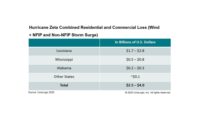Bloomberg: Hurricane Sandy Economic Impact Could Exceed $20 Billion

Hurricane Sandy’s economic toll is poised to exceed $20 billion after the biggest Atlantic storm slammed into the Eastern U.S., damaging homes and offices and flooding subways in America’s most populated city, according to a Bloomberg story.
The total would include insured losses of about $7 billion to $8 billion, said Charles Watson, research and development director at Kinetic Analysis Corp., a hazard-research company in Silver Spring, Maryland. Much of the remaining tab will be picked up by cities and states to repair infrastructure, such as New York City’s subways and tunnels, he said.
“It is really hard to tell at this stage since the system is still moving, but it will be among the 10 to 15 most damaging storms and probably the top three in the Northeast after Irene and Agnes from 1972,” Bill Keogh, president of Eqecat Inc., an Oakland, California-based provider of catastrophic risk models, said in an interview on Bloomberg Television.
Sandy, spanning 900 miles, slammed into southern New Jersey at about 8 p.m. local time and brought a record storm surge of 13.88 feet (4.2 meters) into Manhattan’s Battery Park. Flooding, high winds and fallen trees cut power to about 8 million customers from South Carolina to Maine, and travelers were stranded as U.S. airlines grounded more than 16,000 flights. U.S. stock trading is closed again today in the first back-to- back shutdown for weather since 1888.
See the complete story by clicking here.
Looking for a reprint of this article?
From high-res PDFs to custom plaques, order your copy today!






